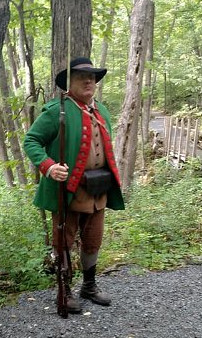
Challenging Sentries
Signs & Counter Signs
Sentries and guard posts provide security for encampments against thieves, spies and attack by ensuring only those with proper authorization are admitted. Signs, counter signs, and paroles were the means to confirm authorization and were required for entrance into secured areas. Counter signs, and paroles are chosen by the Commanding Officer or Officer of the Day. All guard posts, sentries, and vedette leaders are to know them.
All guards and sentries are to challenge all who approach the post, even their own relief party. Similarly, all approaching parties are expected to know the signs and give them when challenged. The parole was reserved for the Officers in order to confirm an order. For example, if an unfamiliar Officer arrives with orders to recall the guard and return to camp, the commander of the guard requires giving the parole in order to validate the order.
When a guard/sentry is approached by an individual or party, he requires them to stop and identify themselves. Once the identification is given, the post/sentry orders that one member of the party approach the post to be interrogated. That one man should approach without arms, or with his arms clearly displayed and safe to a distance of about 6 yards, and give the counter sign. For example:
Sentry: “Halt! Who goes there!”
Approaching Party: Identifies itself e.g.: “Grand rounds!”, “Patrol”, “Cpl. Jones – 1st Company” (no more loudly than the situation requires)
Sentry: “Advance one to be recognized!” The approaching party sends forward one man (generally the ranking individual) to approximately 6 yards from the sentry/post and gives the counter sign.
Sentry (if satisfied): “Pass.”
If at any point the sentry is not satisfied with the approaching party’s conduct, he shouts “Alarm!” and fires immediately, whether he has a target or not.
Signs and counter signs may take forms other than described above. A visual sign such as a hand signal or motion and avenue of approach may be used. In the field, using an approach sector or path as the sign itself is a very useful method for total silence. A curious or zigzag path (perhaps from one tree to another and back again) is designated as the approach sign. The approaching party moves along this exact path and then stops in a designated area; the sentry then moves to the party, and a hand signal is exchanged, at which time the approaching party is passed.
